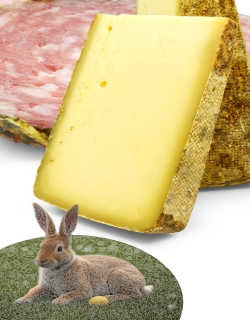Cheese dough quality
Detecting cheese defects and quality – on the cheese dough
Recognizing cheese defects requires some practice.
A good dough texture in cheese is significantly influenced by the water and fat contentThe F.D.M. value related to dry matter, also depending on the water content of the cheese. The higher the water content (the more watery the cheese) the less dry matter and the less fat the cheese contains. » More info.
The cheesemaker therefore needs to pay close attention to the processing milkCheese milk is the milk intended for the production of cheese, also with the concomitant use of buttermilk products, cream products, sweet whey, sour whey and whey cream (whey cream) » More info in order to keep the quality. To make matters worse, the composition of the milk, despite the greatest care, can be subject to significant fluctuations.
If the dairy farmer knows the composition, the fatThe dry matter refers to that portion of the cheese that remains after removal of the water contained. The more water is removed from the cheese, the lower its dry matter and vice versa. » More info content in the cheese can be set fairly precisely. The adjustment of the water content is more complex and places high demands. The expertise of the dairyman makes it possible to optimally choose the process parameters that are decisive for the water content and to coordinate them.
A regular check of the content values of the delivered hay milkHay milk comes from cows that are fed exclusively with fresh grassland feed, hay and little grain. » More info is a prerequisite to avoid daily and seasonal fluctuations in the fat and water content in the cheese as much as possible. If this succeeds, an important foundation is laid to achieve a high quality and balanced quality of dough.
In addition to the most common dough defects, short and dry, there are also occasional flaws such as brown spots, gray spots or greasy dough. Occasionally, gray-blue discolorations occur on the flat side under the grease.
Too strong cheese dough
Solid dough is in most cases the result of too low water content in the cheese. If the cheese additionally has a low F.D. – this increases the error. If a large amount of added water in the cheese production is not compensated by a stronger proteolysis (WLN), this can promote the error. If the dough develops firm, short and bright during ripening, it is often due to defective proteolysis (NPN).
Short cheese dough
A short dough structure may e.g. due to excessive syneresis during the manufacturing process, incorrect lactic acid fermentation or atypical proteolysis (WLN, NPN).
Dry cheese dough
The causes of dry dough are not always obvious. The error can occur as a result of excessive syneresis and / or too rapid acidification in the cheese during lactic acid fermentation. As a cause but also a slightly defective proteolysis must be considered. If the ratio WLN to NPN is in imbalance in favor of the NPN, the error “dry” can be favored
Polka dots / stains in the cheese
Brown specks or gray spots on the cut surface reduce the quality of semi-hard cheese. Particularly at risk are the zones under the cheese scars at the age of 3 to 6 months (ripening error). Brown spots are caused by propionic acid bacteriaBacterium Linens (red culture bacteria) are brushed with salt water on the cheese. » More info, which form visible colonies in the cheese dough. Gray spots are usually visible colonies of
Enterococci. The emergence of these errors is based on an often complex interaction of different factors.
Gray-blue discoloration flat beneath the grease
This error occurs during maturation. On unwashed cheese wheels the error is often barely perceptible. When the cheese is washed, the error becomes clearly visible. Typical signs of discoloration of this type are atypical proteolysis and increased pH in the affected area.
Greasy dough
Here are the ingredients to check. Often there is too high a fat content, reinforced by an increased water content. In addition to a labfähigen processing milk is to pay particular attention to a good syneresis. Sluggish pH on the press and / or end pH below 5.10 will degrade the waste and lead to an acidic cheese dough.


















